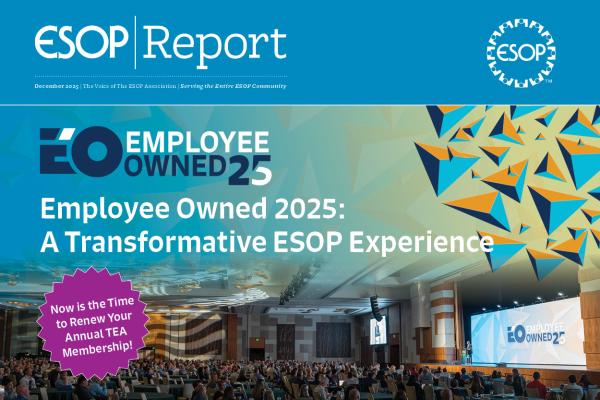This question comes up frequently, both inside and outside of the ESOP community. The total number of ESOPs is stable, with about 200-250 created and a similar number terminated per year. High-profile campaigns from Ownership Works and Expanding ESOPs focus on the idea that ESOPs are good and we need more of them1 , but they also assert ESOP policies are broken because the number of ESOPs isn’t growing (even though the number of employee owners is rapidly growing). Expanding ESOPs specifically has tried to identify some of the problems2 , but its proposed solution is to create a whole new type of plan with its own entirely new system of tax incentives that only private investment funds would be eligible to access and label as an ESOP.
Many well-intentioned members of the ESOP community have shown support for Expanding ESOPs (the organization) because they genuinely believe in employee ownership, and they really don’t hold a preference about what form that ownership takes. However, the community should treat the conversation entirely differently when the approach to expanding the number of ESOPs is to invent something new and just slap the ESOP label on it.
Many people suggest a lack of awareness about ESOPs as a key reason why few companies form them. Expanding ESOPs cites a polling statistic of just 3% having heard about “broad-based employee ownership.”3 However, with more than 14 million current plan participants, that alone represents more than 10% of all American households. A more accurate number comes from the Rutgers Institute for the Study of Employee Ownership and Profit Sharing, which says “67% of business respondents overall and 84% of respondents in companies with 50 or more employees were somewhat or very familiar with ESOPs.”4 Or the 2024 study conducted by The ESOP Association (TEA) of more than 275 business owners that showed 2/3rds (68%) were likely to consider selling their business through an ESOP, which was on par with other exit strategy options.
TEA has pursued the goal of creating more ESOPs since 1978 and draws on decades of experience. More likely than a lack of awareness, there are three significant reasons that ESOP growth has slowed in the last two decades.
1.Dilution of ESOP Tax Incentives
Two separate long-term trends in tax policy have affected the value of the ESOP tax treatment. First, the 1042 benefit is half as valuable as it once was because capital gains taxes are half as much as they used to be. The primary tax incentive for business owners to sell their company to an ESOP is to take advantage of the IRS Section 1042 tax deferral, first established in 1984. This provision allows business owners to defer paying capital gains taxes on the proceeds of the sale if they meet certain conditions. When Congress raised the top effective capital gains tax rate to 28% in 1986, Section 1042 was a very enticing incentive for business owners to avoid a large tax bill. However, as Congress later decreased the capital gains rate to 20% in 1997 and then even further to 15% in 2003, the incentive provided through Section 1042 decreased as well. Even among ESOP founders who are initially interested in the 1042 deferral, many ESOP professionals report that their clients ultimately choose not to take the deferral, choosing instead to structure their deals to minimize tax exposure and then accept the comparably low tax payment of 15% (or lower) so they are not constrained at all in how they use the sale’s proceeds.
In addition to the diminishing appeal of the 1042 deferral, a second factor has been the reduction in corporate tax rates, which has steadily reduced the relative advantages of forming a C-corporation ESOP. Expanding ESOPs claims that these changes make alternative ownership and compensation structures more attractive in comparison. They aren’t entirely wrong. C-corporation ESOPs remain a viable and often advantageous structure, particularly in cases where a partial ESOP is desired. For example, if a single family member wishes to exit a familyowned business while maintaining C-corporation status for strategic, liability, or tax reasons, a C-corporation ESOP can offer a flexible and tax-efficient solution. The existing tax incentives for ESOPs have eroded over time, perhaps deeply. Congress, considering its longstanding bipartisan support for ESOPs, should consider this factor in future tax legislation. But at what level should these tax benefits take effect? For decades 30% has been the point at which ESOP tax incentives are triggered, far above the 10% stake contemplated by private equity proposals. Why? Because at this level, the benefits of ownership become more widespread for employees.
2. Excessive Lawsuits, Audits, and Investigations
With both government and the plaintiff’s bar looking over the shoulders of business owners and ESOP professionals, excessive litigation has become a significant deterrent to forming an ESOP. The Department of Labor (DOL) has engaged in a National Enforcement Project against ESOPs since 2005.5 The Employee Benefits Security Administration (EBSA) has disproportionately investigated ESOPs6 , and EBSA has colluded with the plaintiff’s bar through common interest agreements7 . All of this has produced a “chilling effect” on ESOP formation, which was evidenced in the Pepperdine Cost of Capital survey from 20218 , which showed that business owners believe that government/DOL oversight is a reason to not choose an ESOP.
TEA’s own research from 2024 with business owners again showed the chilling effect that out-of-control litigation has on ESOP formation. Among the quotes from the focus group of business owners were, “I have hesitation when I see Department of Labor” and “I deal with the DOL a lot, it can be very complex” and finally “If the government is responsible, that’s a deterrent.” In short, one business owner summed it up with “If I sell to the business next door, I don’t have to deal with the DOL.” Again, Expanding ESOPs’ assertion is correct that the regulatory and investigation environment created by the DOL is part of the problem holding back ESOPs9 . Anyone following The ESOP Association’s advocacy efforts over the past five years knows it is actively tackling this serious issue – delivering real progress and preparing for further action. Both Congress and the new administration are actively working, in a very bipartisan manner, to resolve this problem, once and for all.
But the problem isn’t that Employee Retirement Income Security Act of 1974 (ERISA) has jurisdiction over ESOPs – the problem is that the federal regulator has a longstanding, anti-ESOP bias and lack of constraint on its oversight. The solution is not creating new, narrowly targeted “safe harbors” for just certain stock incentive bonus plans (which are being marketed as ESOPs, but don’t meet the established definition of one.) Rather, the solution is passing adequate consideration legislation and working with DOL to write proper regulations on this matter.
Setting up an ESOP can be both complex and costly, but the complexity and cost are in many ways being driven by the regulatory environment. TEA and government leaders in both political parties are actively working to fix that problem.
3. Competition
The competition to buy businesses has grown dramatically in the last two decades. This competition is driven almost entirely by the explosion in the number and size of private equity firms, which has risen from 12,000 in 2016 to over 19,000 today.10 Consider how a business owner decides between two options to sell their company: one to a PE firm, and one to their employees though an ESOP. The PE firm’s offer is above market value because it manages portfolios of companies which can be joined or create synergistic opportunities. Plus, PE firms collectively hold record-high dry powder11 and need to put those resources to better use and therefore can justify premiums for the businesses they buy. On the other hand, the ESOP can’t offer above market value because it has a fiduciary duty to the employees not to overpay for the company. It’s easy to see how a competitive market can drive PE firms to consistently outbid ESOPs, or anyone else.
It’s appropriate to ask, “should private equity receive another tax incentive that even further advantages them in the market?" But it’s undeniable that private equity has seen tremendous growth in its size and scope, and an increasing percentage of the economy is owned by private equity. [See our size of private equity piece on page 28] What’s clear is that private equity is a direct competitor with ESOPs for the purchase of many businesses, regardless of the reason for the company’s sale. With private equity already receiving favorable tax treatment, the “silver tsunami” – which should be a huge opportunity for ESOPs12 - may get swamped by an even bigger wave, one fueled by private equity dollars and supported by taxpayers on an unlevel playing field that eclipses ESOPs entirely.
Like the litigation situation, TEA has been actively addressing access to capital issues for ESOPs13 with an alternative strategy. TEAs public policy efforts have included the American Ownership and Resiliency Act (AORA), a bicameral and bipartisan bill.14 AORA establishes a zero-subsidy investment facility within the U.S. Department of Commerce to enable licensed private investment entities (called Ownership Investment Companies) to mobilize private capital for the purchase of privately held businesses transitioning to ESOP ownership. This approach would help address a critical financing gap in ESOP transactions, allowing business owners to sell their companies to their employees rather than selling outside of their communities, possibly to a foreign entity, or closing entirely. Incentives to create more equity capital might be directed to family office, institutional, and PE investors but should include protections for ESOPs to prevent equity investors from flipping companies, wresting control, or selling off assets. Protections for any debt or equity incentives scenarios should also include limits on cost of capital, returns on investment, and might be structured similarly to enterprise or opportunity funds. Instead of creating a whole new type of program only available to certain types of investors, AORA keeps what we know works (ESOPs), has a lower cost to the taxpayer, and has support in Congress.
Yes, TEA agrees that the nation needs more ESOPs. And yes, that means building awareness of them. But that’s not the main reason for the lack of ESOPs. Rather, ESOP growth has been limited by certain key factors, mostly including the issues above, and TEA is working directly on resolving those issues. Could there be a positive aspect to private equity providing some financial incentive for workers? Perhaps “yes” to that too. But the focus should be fixing what's truly holding ESOPs back, not redefining ESOPs.
Sources
[1] Should Companies Be Owned by Their Workers? - Freakonomics Radio, Episode 587, May 8, 2024 “Look, I think ESOPs are great. It’s different than what we’re doing. I’m not trying to diminish it, but we need more.” – Pete Stavros
[2] Why Aren’t There More? – Expanding ESOPs
[3] Polling Data – Expanding ESOPs
[4] https://assets-eof.s3.us-east-2.amazonaws.com/assets/public/2025-10/ Research-Brief-final_Barriers-to-Adoption-Among-Sellers-WhoConsidered-ESOP-Scharf.pdf
[5] Enforcement | U.S. Department of Labor
[6] https://www.oig.dol.gov/public/reports/oa/2009/05-09-003-12-001.pdf
[8] 2021 Private Capital Markets Report | Employee Ownership Foundation
[9] https://expandingesops.com/why-arent-there-more/
[10] https://www.bloomberg.com/news/articles/2025-10-01/-crazy-rightmore-pe-funds-than-mcdonald-s-signals-pressure
[11] https://www.institutionalinvestor.com/article/2di1vzgjcmzovkcea8f0g/ portfolio/private-equitys-dry-powder-mountain-reaches-record-height







